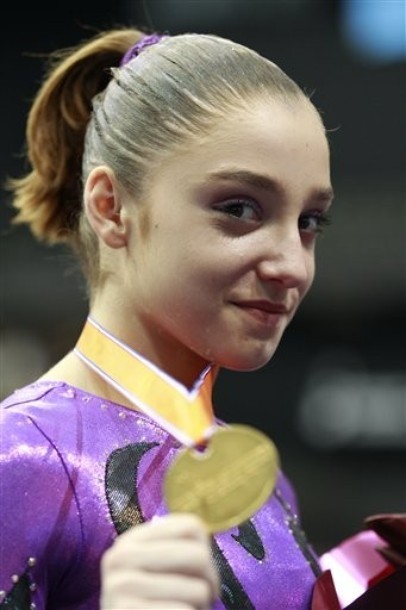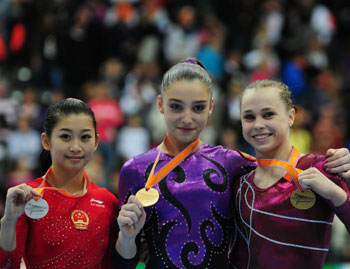"And now is the winter of our discontent."
Perhaps when Shakespeare wrote these lines he was inspired by an emotional response to the end of the gymnastics year in terms of major competitions. Probably not, but for those die hard fans among us, the slow march into December can be a bitter pill to swallow. In many ways, the very second the last event final medal is draped across a gymnasts’ shoulders at a World Championships, the same dreary anticlimactic misery descends over you in a manner reminiscent of childhood boxing days: you had a great time, and may even have got everything you wanted, but despite any good feelings you know that you are now the furthest you can be from Christmas day.
Luckily, this isn’t one of those years. It is already impossible to say “2012” without a thousand adverts and exaggerated promotional slogans bursting into your head. Yes, we are about to embark upon an Olympic year. And personally, I have never been more excited. I know more about the sport than I ever have, am much happier with the state of the sport than I was in 2007, and it is in my home country. What more could a guy ask for?
London 2012: anticipated in the media with the same urgency as a coming apocalypse. But its hard not to share in the excitement.
But enough of that. Stretching ahead of us is a barren tundra of time filled with boring Olympics speculation, so the time for hysterical anticipation is not now. Now is the time to look back over a year in gymnastics and appreciate the good moments, note what has changed and ponder upon the validity of our former expectations. Below is an incredibly brief summary of how 2011 panned out for last year’s big WAG names.
2011 IN BRIEF.
We left 2010 in awe of Aliya Mustafina. Whether we hated, loved or couldn’t make our minds up about her, she was without a shadow of a doubt the gymnast to watch coming into the 2011 gymnastics year. She absolutely smashed the 2010 all around, putting up incredibly solid performances on each of the four apparatus (of which she had no real noticeable weakness, somewhat uncommon in modern gymnastics). Aliya was the reigning queen, and Rebecca Bross her vanquished opponent. Fading away slightly following her disappointing bronze medal finish in the 2010 worlds AA, we heard very little form Rebecca following this competition. But her fantastic performance on floor left a lasting memory.
Killed. It.
For me, the first big competition of the new season was the American Cup. Although dogged with judging fiascos, this event is usually a long awaited relief from competition wilderness and we usually get a good look at how the American’s are doing. Rarely do we get a look at the reigning gymnastics top dog slogging it out against her bushy tailed new kid on the block rival: yes, this year’s American cup was all about Wieber vs Mustafina. There is nothing quite like a good old Russian/American rivalry and this competition was no exception. Mustafina showed she was even more formidable than before, with an upgraded bars set that was quite simply incredible (inbar 1/1 - tkatchev - pak - stalder ½: NOW THAT’S a combination). However, Wieber managed to edge her out with better consistency on beam, a nicer vault and less floor mistakes. The two had proven they were a match for one another. Aly continued her quieter but super impressive consistency (on all but bars).
Just great.
By the time Europeans rolled around we were all well and truly ready for Aliya to be European champion. It seemed inevitable. But disaster struck: the vault that execution sticklers the world over had been bemoaning for the best part of a year caused Mustafina to tear her ACL. And just like that, she was gone. Fan favourite Anna Dementeyva took the AA gold in her teammate’s absence. Europeans provided us with our first good look at world champion uneven bars worker Beth Tweddle, who showed up with an even harder bars routine filled with insane connections (most of which she missed in finals, causing her to win gold by the narrowest of margins against the assault of Tatiana Nabieva, Russia’s famous skill chucker).
Meanwhile in Australia, Aussie superstar Lauren Mitchell was showing some cool new connections on beam, but looking like she was slowing down a bit. Similarly, over in China, the annual nationals showed former world champion Deng Linlin fail to make the beam podium even within her own country (and even with a new super hard combination under her belt). Bars superpower He Kexin was also showing some signs of growing pains, with increasingly laboured work and a worsening pak. Despite this, there were hints of the potential debut of a new double pirouette skill.
By the time of the VISA nationals, people were poised for the long awaited return of Rebecca Bross and her campaign for a third shot at the world AA title. What they got instead was very hard to watch indeed. After an incredibly messy two days of competition (with the notable exception of floor which was good as ever), Bross took a terrible landing on her DTY and dislocated her kneecap. And thus the top two AAers of the previous year were out for the count.
Worlds happened, and we know what happened there. It was a win for the new blood, with the notable exception of Ksenia Afanasyeva, the long time Russian underdog who finally struck gold with a fantastic showing on floor.
So, looking to the huge event that is next year, how are our old timers doing? (and inspired by a recent intlgymnast thread)Whose stock is up and whose is down? In my opinion this goes broadly as follows
UP
Ksenia Afanasyeva - showed she is not only a team player but capable of success in her own right
Tatiana Nabieva - a gymnast who was previously famous mainly for doing high level skills to a very poor standard showed that she could tone it down, clean it up and win a medal
Catalina Ponor - showed that despite missing pretty much a whole quad, she can still pull out some cracking performances and make an event final on her signature apparatus
Alexandra Raisman - She scooped her first individual medal on the floor, and put in her usual super solid appearances in the team final. She would be an even better position, however, had she finally managed to hit bars in the AA. She didn’t.
Sandra Izbasa - A strange one given that she didn’t compete at these worlds, but the poor team performance of the Romanians showed that they need her next year
DOWN
Yoana Dufournet - A medal was hers if she hit. But she didn’t. Seems like she is running out of chances to prove herself
Beth Tweddle - in terms of her floor. I am a huge Beth fan and I have to admit that it was AWFUL at worlds. BUT her bars routine in TFs was the best and most difficult I have ever seen her do, so she is up in that respect
Lauren Mitchell - No EFs from original qualifications. Then a shoe in. Then no medal.
Jiang Yuyuan - no all around for the previous silver medallist. Outshone by the young ones and unlikely she will be up there again
He Kexin - Inconsistency, growing pains and being removed from the team lineup by a country that isn’t hard on headcases all equal a plummeting stock. This might spell the end of the road for this former Olympic champion.
Alicia Sacramone - it pains me to say it, but her injury at worlds had more than just a physical impact. The US proved that they can win without her, and who knows how far she will be set back by this injury in terms of her upgrades (in particular her handspring 2/1 twist).
So in conclusion, has much changed? We have seen plenty of the old cast members fade away in the shadow of many bright young things. But in terms of the All Around, the potential returns of Bross and Mustafina are still a big threat in the AA. The coming year is shaping up to be one of the best of its kind: I can’t wait.














